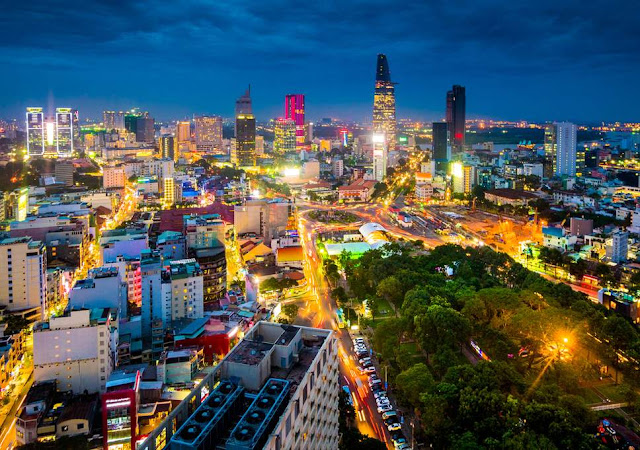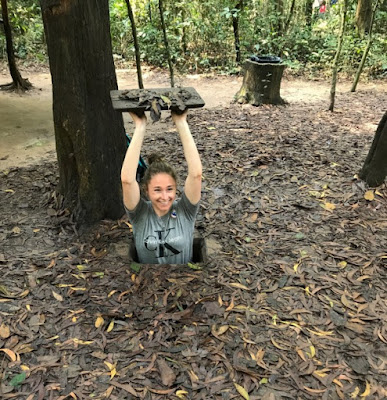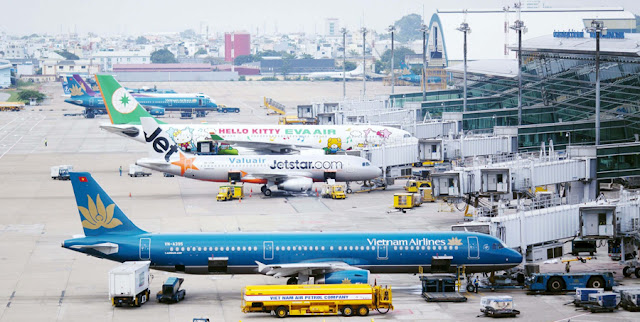The Definitive Travel Guide to Ho Chi Minh City - Indochina Travel Blog

Overview
Ho Chi Minh City is the largest city in Vietnam with a population of around 7 million. Although it was renamed back in 1975 after the Vietnam war, it is still commonly referred to as Saigon by both Vietnamese and foreigners alike. Ho Chi Minh City, former capital of South Vietnam, is located in the south of Vietnam about 1,750 kilometres south of Hanoi, todays capital. The city centre is situated on the banks of the Saigon river.The wide avenues, a smattering of decaying French influenced architecture, sidewalk cafes and baguettes, seems to be the only evidence left that the place was occupied by the French. But it's enough to give it a very different feel from any other Asian City.
Ho Chi Minh is still the economic heart of Vietnam and the streets bustle with activity, not to mention what seems like an endless stream of motorbikes. Vendors, markets, shops, stands and cafés crowd the busy streets and sidewalks adding to the vibe. Booming economically, chic bars and clubs have popped up around the city to be crowded by affluent Vietnamese and expatriates
Political and administrative system
Ho Chi Minh city is divided into 24 district sub-level with 19 urban districts and 5 rural districts. See the list below:
- Rural District: Cu Chi; Hoc Mon; Nha Be; Binh Chanh; Can Gio
- Urban District: District 1; District 2; District 3; District 4; District 5; District 6; District 7; District 8; District 9; District 10; District 11; District 12; Go Vap; Tan Binh; Tan Phu; Binh Thanh; Phu Nhuan; Thu Duc; Binh Tan
Festivals
Lunar New Year (Tet) Festival - The Tet Festival is the Vietnamese New Year or Lunar New Year, which is the same time as Chinese. During this period, visitor can expect to see decorations all over the city, parades, food stands, and beautiful fireworks displays. It is believed that during this time of year, those who start a new business or project will have good luck.
Reunification Day - Referred to as Liberation day, this holiday, celebrated each year on April 30th, commemorates the moment the Viet Cong and North Vietnamese troops captured Saigon (now Ho Chi Minh) in 1975.
Independence Day (02 September) - This day marks Vietnam's Independence Day. During this national holiday, thousands gather to celebrate and throw parties together. Concerts are held throughout the day, and during the evening celebrations, the city puts on an extravagant fireworks display.
Ghost Festival (Soul Festival) - A Buddhist holiday, this event is intended to celebrate the souls of the dead that are thought to visit the city during this time (the 15th day of the 7th lunar month). During this holiday, religious ceremonies are performed, and traditional food is prepared as offerings to the wandering dead. (It sounds scary)
How To Get To Ho Chi Minh City
Things To Do & Places To Visit
War Remnants Museum: One sided view of the "American war" is well worth visiting. This place covers 5,400 square meters, in which the exhibition area is 4,522 square meters. It includes many buildings that store military equipment, photographs from the effects of Agent Orange, Napalm and Phosphorus.


Address: https://goo.gl/maps/SD3pwymJLvp
Notre Dame Cathedral: The building’s architecture was based on Notre-Dame de Paris. It
possesses numerous historical values and also cultural values.
Notre-Dame Cathedral Saigon was built with materials imported from
France. With a height of 57.6 meters, its bell towers is are highest
ones in Vietnam. Only on Christmas Eve will all the bells ring together
Ho Chi Minh Central Post Office: The office was built
from 1886 to 1891 by The French under the design of the architect
Villedieu with an assistant named Foulhoux, combined European style with
Asian decor
You can easily find Ho Chi Minh Central Post Office from Notre Dame Cathedral.
Address: https://goo.gl/maps/2SZkeToDJG32
Mekong Delta - The Mekong Delta
has been dubbed as a “biological treasure trove”. Over 1,000 animal
species were recorded between 1997 and 2007 and new species of plants,
fish, lizards, and mammals have been discovered in previously unexplored
areas

(Read more: https://indochinatravelgeek.com/vietnam/mekong-delta-day-trip-travel-guide/)
It will take you approximately 1–2 hours to go to Mekong Delta (by car) from Ho Chi Minh
Cu Chi Tunnels - These underground tunnels network cover an area of 150 square kilometres. They were a major thorn in the side of the US during the war, considering they were so close to Saigon. Even with heavy B52 bombing the tunnels remained a major Viet Cong defensive system.
 |
| Travelers love exploring Cu Chi Tunnels while traveling in Ho Chi Minh city |
The tunnels are an immense network of connecting underground tunnels located in the Cu Chi District of Ho Chi Minh City and are part of a much larger network of tunnels that underlie much of the country
Ben Thanh Market (Le Lai Street), one of the city's most famous landmarks. Bustling with activity at night with vendors selling everything from snacks to souvenirs and cheap clothing.
 |
| Ben Thanh Market |
The old market was originally built with brick and wood. Even back then, it’s still one of the most crowded places in the city.
Binh Tay Market: Binh
Tay market is one of the largest in Ho Chi Minh City and is over 17,000
square meters in size. It is also home to more than 2,300 vendors
selling a number of different products including fresh food,
ingredients, fruits, textiles, home appliances, handicrafts and more.
Khai Silk - (Dong Khoi street) is a lovely luxury shop for purchasing good quality silk shawls - both the Kashmiri pashmina shawls as well as the Vietnamese raw silk shawls.
The Dong Khoi street shops are a tad expensive than shops elsewhere in Ho Chi Minh city but the quality is much better
Weather
Best time to visit Ho Chi Minh city is in the dry season which runs from December to April. In the dry season the humidity is at a level which is easier to handle.Most visitors come Dec–Apr, when the tropical weather is warm and dry. The rainy season is May–Nov. Key events and holidays include Tết, or Vietnamese New Year (Jan/Feb, dates vary), for which many businesses close, and the Mid-Autumn/Full Moon Festival (Sep/Oct, dates vary), celebrated with mooncakes and lanterns.
Vietnam Weather Infographic






Comments
Post a Comment